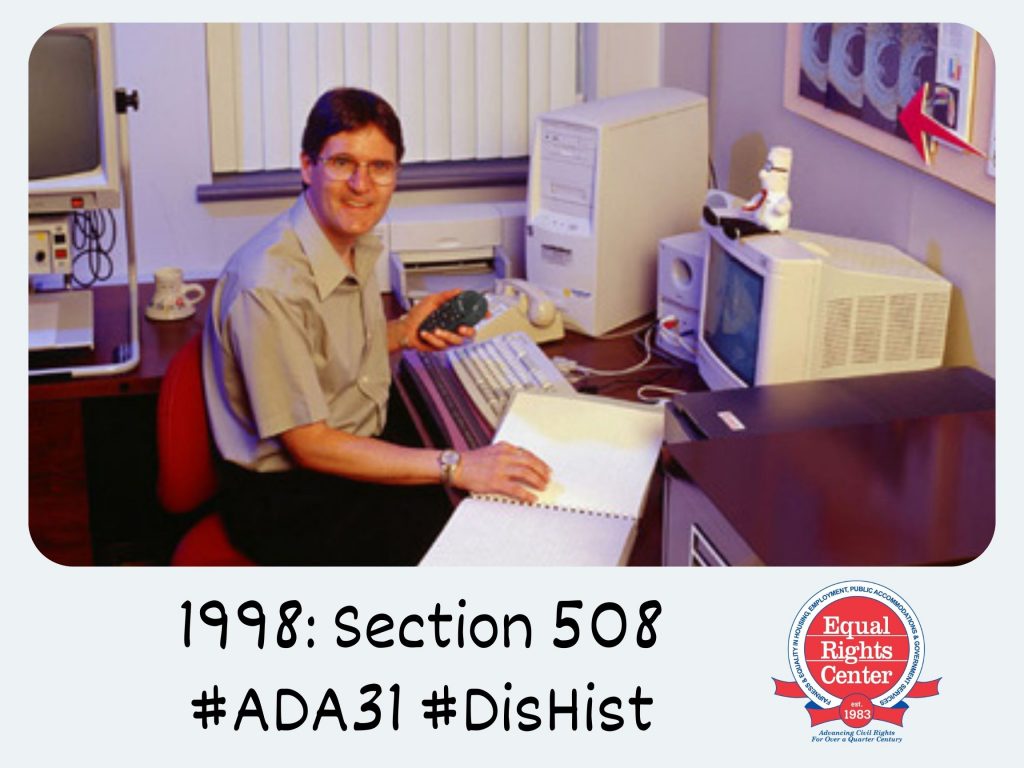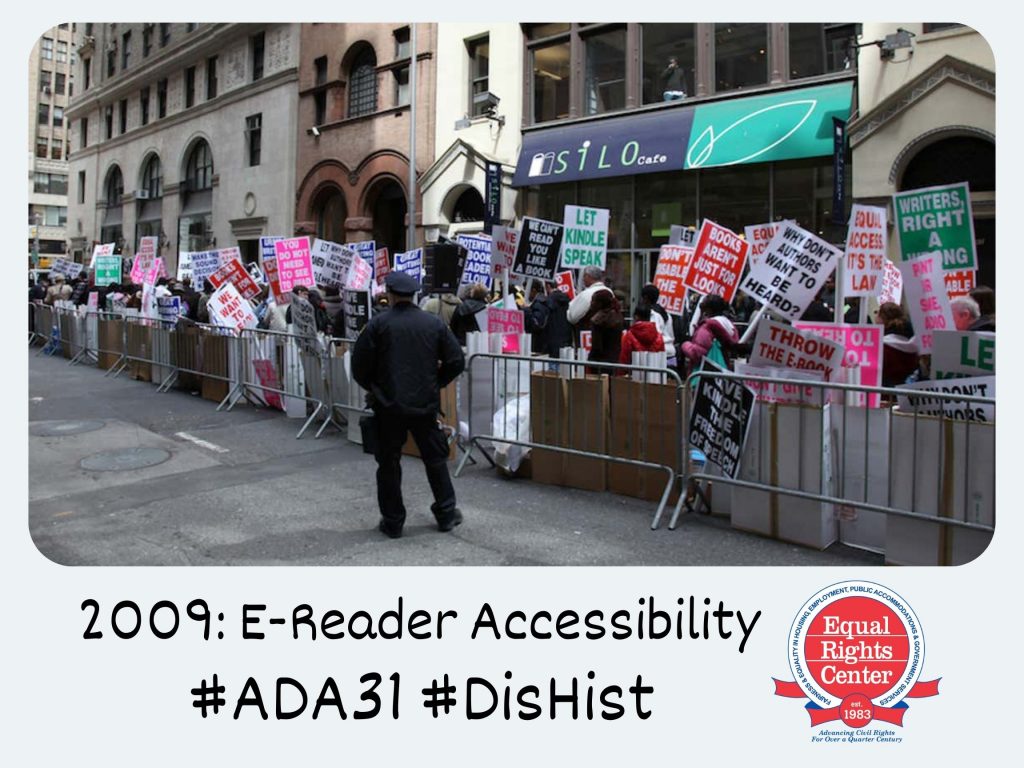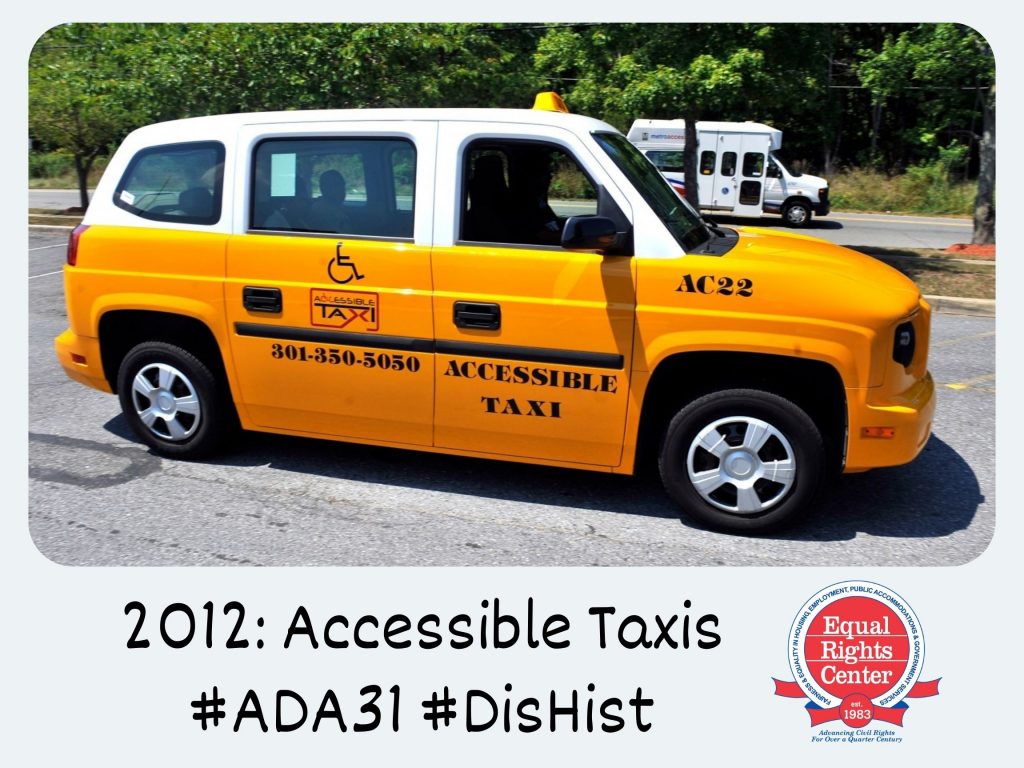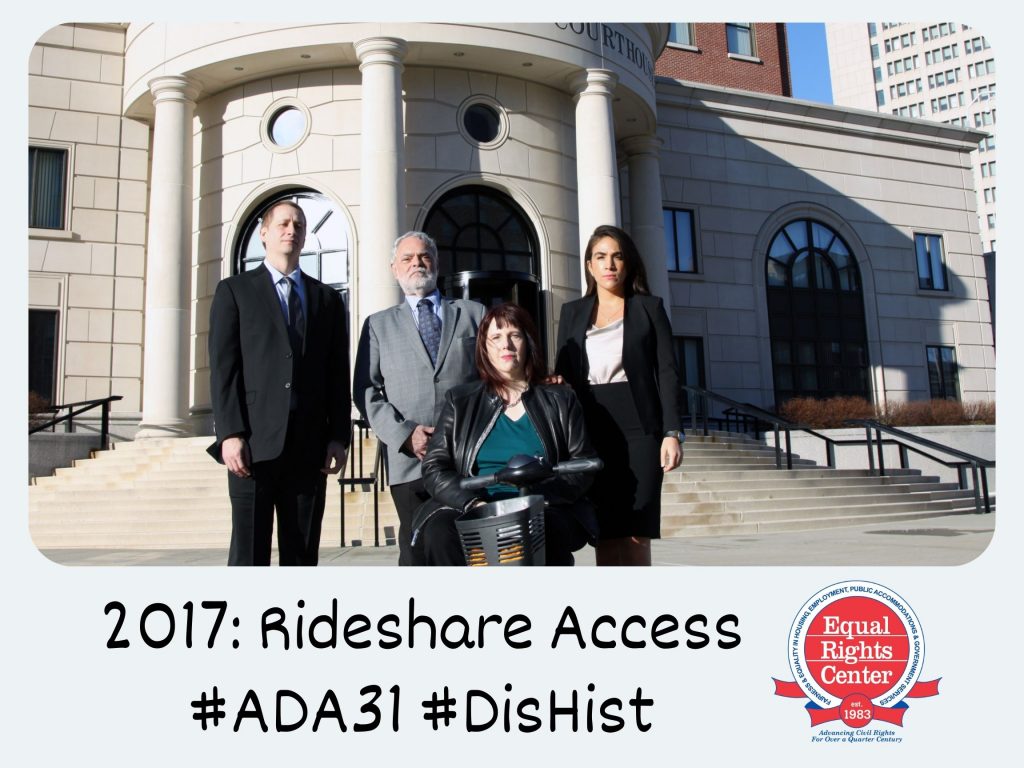ADA 31st Anniversary Commemoration
July 29, 2021
July 26, 2021 marked the 31st anniversary of the Americans with Disabilities Act (ADA). To celebrate the milestone, we took to Facebook and Twitter to share 31 moments from the past 31 years highlighting major wins for disability rights, as well as continued barriers to access. If you missed it, or if social media just isn’t your thing, don’t fret! We’ve compiled all 31 posts into a mini history lesson for you right here.

The ADA was passed thanks to the tireless activism of people with disabilities. On March 12, 1990, activists cast aside their wheelchairs and mobility aides and crawled up the steps of the Capitol to support the Act. It was signed into law four months later.

The Fair Housing Act requires all “covered multifamily dwellings” designed and constructed for first occupancy after March 13, 1991 to be accessible to and usable by people with disabilities; however, lack of affordable, accessible housing remains an issue today.

People with disabilities quickly found that the ADA’s promise of accessibility would not be realized without continued pressure on offending parties. This photo shows a 1992 rally to pressure New York City government to fit the city’s streets with curb cuts.
- Photograph by James Estrin. The protesters holding signs are Joyce and Angelo De La Rosa.

Disability rights activists borrowed many tactics from the Civil Rights Movement of the 60s, like demonstrations of civil disobedience. At the 1993 Disability Independence Parade, activists displayed this banner, featuring a quote by Dr. Martin Luther King Jr.

On January 24, 1994, a federal court sided with Rachel Holland, an 11-year-old girl with intellectual disabilities who had been denied the opportunity to learn in a general education classroom, paving the way for more inclusive classrooms across the country.

Justin Dart, Becky Ogle, and Frederick Fay founded “Justice for All” following calls to amend or even repeal the ADA. They rallied a huge grassroots campaign to save the law. Featured here, activist Marca Bristo’s 1995 letter to the editor defending the ADA.
- To learn more, check out this archive of materials from former Senator Dole’s office. The archive contains over 12,000 pages of documents, correspondence, and speeches concerning the needs of Americans with disabilities.

On January 23, 1996, Sandra Jensen became the first person with Down syndrome to receive an organ transplant in the US. This milestone came after a massive campaign against hospitals that rejected Sandra from their transplant programs.
- “Doctors did not believe a woman with Down syndrome would be able to follow a strict post-surgery routine.” To prove that she was a suitable candidate, Sandra lived in her own apartment, handled her own money, and cooked her own meals. Learn more.

For decades, activists have used various tactics in their campaigns for accessible transit. This photo, from 1997, shows activists blocking a Greyhound bus in an act of civil disobedience. Inaccessible transit remains an issue to this day.

Throughout the 1990s technology rapidly developed. In 1998, the Rehabilitation Act of 1973 was amended to include Section 508, requiring the Federal government to make their electronic and information technology accessible to people with disabilities.

On June 22, 1999, the Supreme Court held that people with disabilities have the right to live in the communities of their choice, rather than face institutionalization, following a lawsuit brought by Lois Curtis and Elaine Wilson under the ADA.

For the ADA’s tenth anniversary, @amhistorymuseum opened an exhibit highlighting the history of the disability rights movement, featuring accessible web-based kiosks. Follow the link to interact with the exhibit as a museum-goer would have: https://americanhistory.si.edu/disabilityrights/

In 2001, golfer Casey Martin won a lawsuit against the PGA Tour, which had required all players to walk between shots during a portion of the tournament. The Supreme Court ruled that the tour must accommodate Martin’s disability by allowing him to use a golf cart.

The Help America Vote Act was signed into law on October 29, 2002, designed to increase turnout for people with disabilities by make polling places accessible and facilitating the use of accessible voting procedures. Voting inaccessibility remains a problem today.

On September 3, 2003, roughly 200 people with disabilities set out on the Free Our People march, a 144-mile trek from Philadelphia, PA to Washington, DC to protest in support of increased funding for in-home support services. They reached DC two weeks later.

In 2004, the ERC sued Archstone-Smith following a testing investigation finding the developer’s properties did not comply with accessibility requirements. The settlement required Archstone to bring over 10,000 units into compliance.

The Disability Rights Council of Greater Washington was a civil rights group that advocated for the needs of people with disabilities, from MetroAccess improvements to healthcare equity and more. The organization and its membership joined the ERC in 2005.

In 2006, the National Federation of the Blind sued Target, alleging that the retailer’s website was inaccessible to blind shoppers. The case is significant as it established that online venues can qualify as places of public accommodation under the ADA.

The Convention on the Rights of Persons with Disabilities is an international human rights treaty adopted by the United Nations. 160 parties signed the Convention upon its opening in 2007 and 126 ratified it within five years. The US, notably, is not one of them.

In 2008, the ERC launched its Multifamily Housing Resource Program, dedicated to helping housing industry leaders comply with accessibility requirements, and increasing the number of accessible apartments and condominiums. Today there are over a dozen members.

Amazon’s “Kindle 2” e-reader offered a text-to-speech function, but in 2009, the Authors Guild successfully lobbied Amazon to allow authors and publishers to deactivate the feature on their titles. Here, activists protest the Authors Guild’s position.

On July 26, 2010, over 1,000 people gathered at the Boston Common to celebrate the 20th anniversary of the ADA. “My ability to work, my ability to live independently… Without the ADA, we wouldn’t be where we are today,” said attendee Rob Park.

In May of 2011, ADAPT activists occupied the rotunda of the Cannon House Office Building to protest Rep. Paul Ryan’s Medicaid plan, which they said would force people with disabilities to live in nursing homes. The proposal was later voted down in the Senate.

In 2012, 15 wheelchair accessible taxis were introduced in Prince George’s County, MD. “This is going to give us a lot of freedom to go places,” said Greenbelt resident Regina Lee at the time. Accessible on-demand transit remains an ongoing need to this day.

“Hollywood has a sordid history of casting able-bodied actors to play disabled on screen.” Maysoon Zayid, an actress with cerebral palsy, gave a TED talk in 2013 highlighting the plight of actors with disabilities. The talk went viral and has educated millions.
- Photograph by Marla Aufmuth and Kristoffer Heacox. Watch the full TED talk here.

In 2014, Haben Girma represented the National Federation of the Blind in a suit against Scribd, a large digital library. Scribd argued the #ADA didn’t apply to online venues, so they didn’t need to make their books accessible, but the judge ruled against them. #ADA31 #DisHist
- Haben Girma spoke about her work on the case in this New York Times article reflecting on the ADA’s 30th anniversary last year.

New York City held its first Disability Pride Parade in 2015, with former Senator Tom Harkin, author and chief sponsor of the ADA, serving as a Grand Marshal. Since the first Disability Pride event in Boston in 1990, parades have been held in over a dozen cities.
The 2016 election spurred a Republican effort to repeal and replace the Affordable Care Act with a plan that would cut Medicaid funding and weaken protections for patients with pre-existing conditions. Protesters, like this ADAPT member, fought back and won.

Harriet Lowell launched a class action lawsuit against Lyft in 2017 for failing to provide equitable service to people who use wheelchairs. As ridesharing has eclipsed traditional taxi service, the fight for accessible on-demand transit has reignited.

A provision enacted in 2018 requires airlines to report to the Department of Transportation how often passengers’ wheelchairs and scooters are reported damaged, lost, delayed, or stolen. Data soon revealed that airlines mishandle roughly 29 devices per day.

Guillermo Robles sued Domino’s Pizza under the #ADA after he was unable to order food on their website and mobile app using a screen-reader. In 2019, the Supreme Court left in place a lower court ruling requiring the pizza chain to make their website accessible.

This past year, the Covid-19 pandemic intensified barriers people with disabilities have faced for decades – from discriminatory healthcare policies to voting inaccessibility. The resounding message from the disability community: we can’t go “back to normal.”
———
The Equal Rights Center (ERC) — a national non-profit organization — is a civil rights organization that identifies and seeks to eliminate unlawful and unfair discrimination in housing, employment and public accommodations in its home community of Greater Washington DC and nationwide. The ERC’s core strategy for identifying unlawful and unfair discrimination is civil rights testing. When the ERC identifies discrimination, it seeks to eliminate it through the use of testing data to educate the public and business community, support policy advocacy, conduct compliance testing and training, and, if necessary, take enforcement action. For more information, please visit www.equalrightscenter.org.

